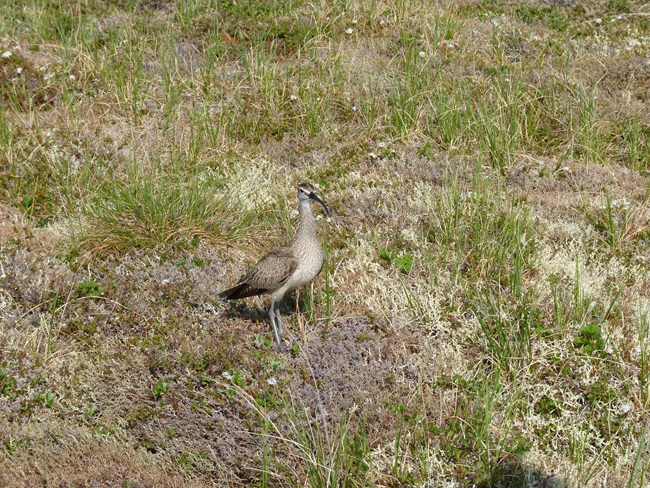
Photo/United States Fish and Wildlife Description Whimbrels (Numenius phaeopus) are 15 to 19-inch long, gray-brown curlew with a stripped crown and a distinctive large (2.75 to 4-inch) down-curved bill. This large shorebird has long, pointed wings with a 31 to 33-inch wingspan and a short tail. It is tan with dark brown stippling with pale feather edges. The crown of its head is dark brown with a pale central strip with most whimbrels having a narrow dark line through its eye. It has black eyes, legs and a black bill. Distribution and Abundance Along the Atlantic Coast Whimbrels nest in the Arctic across North America. Whimbrels can also be found in Europe and Asia. They breed in subarctic regions of Canada and Alaska. They will winter anywhere from Virginia south to Florida and the Gulf Coast to Bolivia. Whimbrels utilize open habitats in tundra for nesting, and mudflats, beaches, and saltmarshes the rest of the year. Whimbrels can be found in Massachusetts during their migration. They are uncommon in the spring and locally common during fall migration, which spans from late July through September. Some hot spots for whimbrels include the Monomoy islands and South Beach in Chatham. Breeding and Feeding Habits Whimbrels breed in tundra habitat where nests are built on raised sites such as a hummock or small ridge for better visibility and usually near a shrub to offer shelter from wind. Whimbrel nests are simple indents in the ground lined with leaves of surrounding vegetation, along with some grasses or lichens. Whimbrels are monogamous during the nesting season. Males will perform a dramatic aerial song flight. Whimbrels will incubate 2 to 4 eggs for 22 to 28 days. The young are born active and with downy. They may leave the nest within one to two hours of hatching and will have their first flight four to six weeks after hatching. Whimbrels search for food in intertidal zone where they will consume marine invertebrates. They also hunt in saltmarshes and mudflats for fiddler crabs. They visually spot the crab’s burrow in the mud and then extract it using their long decurved bills. They also use this technique to capture swimming crabs, mud crabs, crayfish, mole crabs, small fish, marine worms, sea cucumbers, sand shrimp, and small mollusks such as coffee bean snails. They will rinse off the crabs they catch and remove the largest claw before they consume it. These shorebirds will also consume leftover berries from the previous summer including cranberries, blueberries, bearberries, crowberries, huckleberries, and cloudberries. They will also take the opportunity to feed on spiders and various insects. Whimbrels maintain feeding territories in migratory stop-over areas and on wintering grounds by occasionally defending their territory if another whimbrel gets too close. 
Photo/United States Fish and Wildlife Service Threats Whimbrels have lost approximately half of their population in the last 50 years. They are on a trajectory to lose another 50% of their remaining population in the next 50 years if conditions stay the same. Whimbrels are threatened by climate change, sea-level rise, and habitat deconstruction or degradation. As arctic breeders, climate change impacts and resource extractions have a significant impact on whimbrels as they will be forced to adapt. Human disturbance during migration and exposure to environmental contaminants can also impact this species. In wintering areas south of the United States, hunting can negatively affect whimbrel populations. Their dramatic population decline put them on a tipping point where urgent action is needed to help whimbrels before they become endangered. Protections Whimbrels are considered a tipping point species according to the U.S. Committee of the North American Bird Conservation Initiative. This means they could be next to face threatened or endangered status. Proactive conservation could reverse the declines of whimbrels. Identifying causes and key actions, creating solutions with communities, developing a full annual cycle action plan, and taking coordinated action are the strategies that need to be employed to achieve sustainable recovery. Whimbrels could benefit from conservation plans that work with communities toward socioeconomic and cultural solutions for habitat sustainability. Whimbrels are also protected under the Migratory Bird Treaty Act of 1918, which prohibits the take (including killing, capturing, selling, trading, and transport) of protected migratory bird species without prior authorization by the Department of Interior U.S. Fish and Wildlife Service. Cape Cod National Seashore helps to protect critical breeding habitat and migration stop-over areas for many species of shorebirds. The protections allow these species a place to rest and a place to raise their next generations. Things You Can Do to Help Protect Whimbrels and Other Shorebirds
|
Last updated: January 31, 2023
